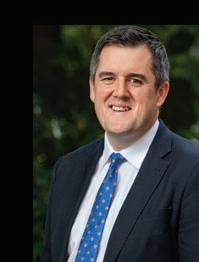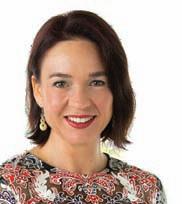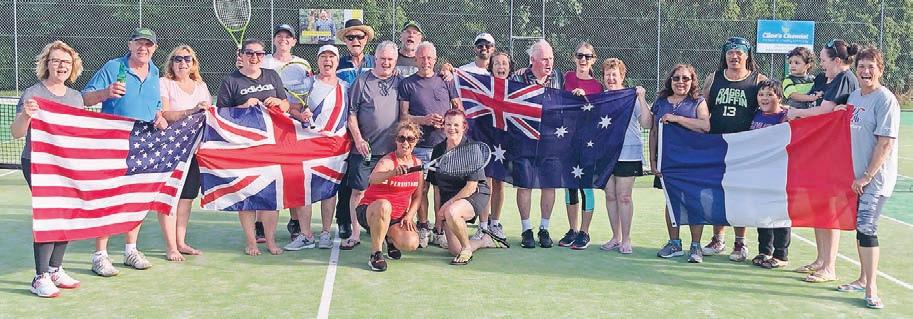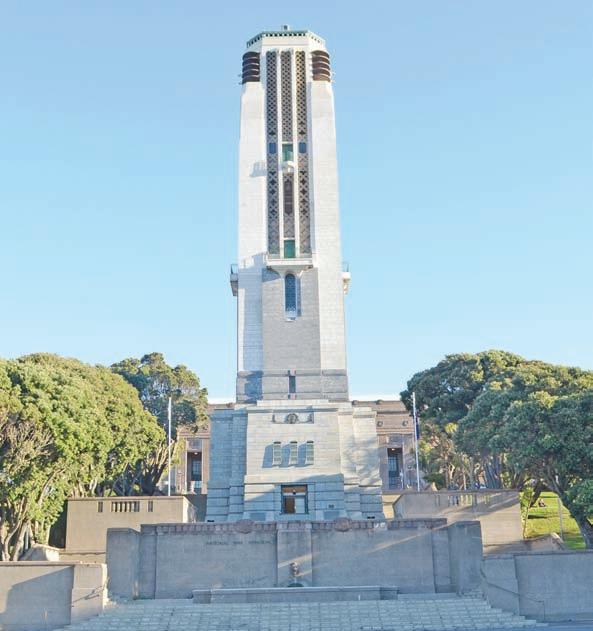Wednesday February 8, 2023




Wednesday February 8, 2023



 By Frank Neill
By Frank Neill
Hutt South MP Ginny Andersen is now a Minister of the Crown. She has been brought into Cabinet ranked at number 19, Prime Minister Chris Hipkins announced on 31 January in a release outlining the


new Cabinet. Her Ministerial portfolios are Digital Economy and Communication, Seniors, and Small Business. She is also Associate Minister of Immigration and Associate Minister of Treaty Negotiations.
Continued on page 2.
Cabinet Minister Ginny Andersen at the swearing in ceremony on 1 February with her mother Tricia Andersen (left), the Governor General Dame Cythia Kiro and her husband Geoff Gwyn. Photo:

Phone (04) 587 1660
Address 23 Broderick Rd, Johnsonville
P.O. Box 38-776, WMC 5045
Fax (04) 587 1661

ONLINE: www.wsn.co.nz
REPORTER
Frank Neill
wainui@wsn.co.nz
027 490 3916
Continued from page 1
“I was humbled and overjoyed to have such a great opportunity to serve New Zealand,” Ms Andersen told the “Wainuiomata News”.
“Becoming a Cabinet Minister is a really big deal for our family,” she says.
Ms Andersen was, in fact, the first member of her family to go to university.
include housing, health, education, and keeping communities and businesses safe.
Another major focus will be “creating a strong economy,” she says.
Ms Andersen’s promotion to Cabinet has been welcomed by Hutt City Mayor Campbell Barry.
“Ginny’s appointment is good news for her and our community,” the Mayor says.

SALES
Les Whiteside les@wsn.co.nz
021 360 008
She studied at Canterbury University, gaining a Master of Arts with distinction in political science.
Her master’s thesis was on the Ngā i Tahu Treaty Settlement, and her first job after leaving university was as a treaty negotiator for the Crown.
“So it is great to be Associate Minister of Treaty Negotiations,” she says.
“We’re extremely lucky to be well represented in Government, and I’m looking forward to continuing to work with her to advance the needs of Wainuiomata and our city at the highest level”.
Ms Andersen was elected to Parliament as a list MP in 2017, and then won the Hutt South seat at the last election in 2020.


NATIONAL SALES
Sam Barnes
sam@wsn.co.nz 021 109 4406
CLASSIFIED SALES classifieds@wsn.co.nz

your local newspaper
She is also really looking forward to continuing her work with senior citizens, now as Minister for Seniors.
“I’m quite grateful that Wainuiomata Grey Power and Lower Hutt Grey Power keep me on my toes,” Ms Andersen says.
“As a new Cabinet we are going to be focused on the cost of living – the bread and butter issues that ordinary people face.”
As well as the cost of living, those bread and butter issues
Before entering the political arena she worked in the public service, advising a number of former Labour Ministers – including Trevor Mallard and David Cunliffe.
One of her public sector roles was with the Police, and in Parliament she has been working on moves aimed at changing New Zealand’s criminal law.
Her member’s bill – the Crimes (Child Exploitation Offences) Amendment Bill – was selected in the Parliamentary ballot in August 2021.
The bill would amend the

Crimes Act 1961 to make it an offence for a person over 18 to use online communications to falsely represent their age or identity with the intention to meet with someone under 16.
The bill would also make it an offence for someone over 18 to use online communications to plan to cause harm to a person under 16.
The bill proposes to increase the maximum penalty for a person
convicted of sexual grooming of a young person from seven to 10 years’ imprisonment. This bill has been considered by Parliament’s Justice Committee (which Ms Andersen chairs) and the committee recommended that the bill be passed.
The next stage is the “third reading” of the bill in Parliament. If Parliament passes the bill it will then go to the Governor General to be signed into law.

I recently hosted a meeting which included local property developers and representatives from the City and Regional Councils. The background for the meeting was the need to ensure all people involved in providing more housing in our electorate, whether it be those building them or those regulating and permitting that building, understand the issues which govern the ability to build the houses everyone agrees we need.
There are essentially two types of development; greenfields and brownfields. Greenfields means building on currently undeveloped land, typically ex farmland on the edges of current urban areas, where infrastructure like sewers, water supply and other essential services don’t exist are usually built by the developer.
Brownfields development means rebuilding on existing sites, and there has been considerable discussion in recent times around how much intensification should be allowed in existing suburbs, especially changing of height limits to allow for more apartments.
Both have their advantages and disadvantages; the Regional Council in particular see their role to prevent more

runoff and other material ending up in our harbours, especially the Porirua harbour in the case of development north of Johnsonville and Newlands. The Wellington City Council are concerned that the existing infrastructure cannot handle the pressure it comes under when new housing areas are developed. Existing infrastructure is aging and needs upgrading across our city, as evidenced by recent pipe failures. An advantage of intensification of existing areas means more people, therefore more ratepayers to pay for those upgrades.
Developers of course need to make a profit, and wish to keep their compliance costs as low as possible. Many believe the Resource Management Act is too cumbersome. We as government for our part have undertaken to rewrite that act.
The feedback was good, but the success will be when there are sufficient affordable houses to meet demand. That is certainly my goal as your MP.
That, and of course having a vibrant and functioning Johnsonville Shopping Centre we can all be proud of.
providing our patients with the best level
I went to a family reunion on the East Coast. We had a very good time.
I’m retired so I had a good break. I pottered around the house and I built a shed.
We had a good break. We went to the Hawke’s Bay for New Year. We had lovely weather.
I went to Brisbane to visit family.
Hutt City is now officially a “welcoming community”.
Hutt City Council has joined the Welcoming Communities programme run by Immigration New Zealand (INZ), INZ announced on 30 January.

It is one of five new councils joining the programme, designed to create inclusive environments where all residents can thrive and
belong.
The council is delighted to join the programme, Hutt City Mayor Campbell Barry says.

"I’m pleased we’re joining the programme, because it puts a specific focus on ensuring our new arrivals are integrated and welcomed into our communities - and it makes good on our commitment to create a city where all our people thrive," Mayor Barry says.
"We are grateful for the enthu-


• New Zealand Diploma in Wellness and Relaxation Massage, Level 5
• New Zealand Diploma in
Remedial Massage, Level 6
• Flexible learning options, distance and block courses
• Study online at your own place and time
• Block courses at Auckland Campus

• NZQA approved and accredited

• International Recognised
• Eligible for loans and allowances
• Fees free policy may apply
• Early payment discount available
Other courses available in Acupuncture, Chinese Medicine and Tuina
Check our website for more details.
siasm shown and the desire from councils around the country to be part of such an important initiative that began five years ago," says Fiona Whiteridge, General Manager of Refugee and Migrant Services INZ.


There are now 31 councils taking part in the programme. Nationally one third of city and district councils are now committed to making their communities more welcoming for everyone.
It wasn’t long enough. The working man isn’t given enough time off. We did a bit of a tour around the South Island.
"This programme is an incredibly important tool for building strong and connected communities, for making newcomers, no matter their background, feel included, so everyone can thrive," Ms Whiteridge says.
Welcoming Communities supports councils and their communities to create welcoming environments for newcomers, specifically recent migrants, former refugees and international students.
The same thing we always do – eat and have visitors.
The programme involves local residents in developing, delivering and participating in welcoming activities. This approach increases social engagement and provides opportunities to build social connections.
Immigration New Zealand provides funding, resources, accreditation, best practice information, networking opportunities, programme evaluation and guidance to participating councils.
The Board will be meeting on Wednesday 15 February 2023 6:30pm, Room 1, in the Wainuiomata Community Library, Queen
Phone: 0800 888 518 | Email: auck@chinesemedicine.ac.nz 321 Great South Road, Greenlane, Auckland Refer

Q: Did you have a good summer break, and what did you do?Diane Hall-Piuselli Frances Saltmarsh Emily Lynch Pat McDonald Horo Wharepapa Rich Russell
The popular Wainuiomata Regional Park swimming hole –known locally as “the ultimate” –is closed.

Greater Wellington Regional Council is building a new retaining wall to stop erosion at the popular swimming destination and closed the swimming hole on 7 February.
The riverbank has become unstable due to the river naturally eating away at the bank and the popularity of the spot with people getting in and out of the river.
In order to make this swimming hole safe and swimmable for years to come, the council will be building a new natural retaining wall using a product called FlexMSE.
This is a retaining wall that
can actually be planted. The idea is that over time these plants will grow and cover the retaining wall with natural foliage, while the bags themselves have a soft fabric surface suitable for swimmers’ feet.
“Unfortunately, this work needs to be completed in the summer due to the water levels being lower, reducing the risk of sediment entering the waterway and avoiding the spawning period of fish,” the council says.
People can keep up to date with progress by visiting Greater Wellington’s Facebook page – https://www.facebook. com/GreaterWellington/ – or the Wainuiomata Regional Park website, https://www. gw.govt.nz/parks/wainuiomataregional-park/.
Most plants flower to produce seeds so their line will continue through their off spring.
When it comes to our gardening efforts we want plants such as tomatoes, zucchini and pumpkins to produce fruit which in every case contain the seeds for the next generation of those plants.
When pollination does not happen then the fruit will only develop a little and then rot.
Pollination is the act of transferring pollen grains from the male anther of a flower to the female stigma.
The goal of every living organism, including plants, is to create offspring for the next generation. One of the ways that plants can produce offspring is by making seeds.
Every year I receive enquiries about what is wrong with my zucchini/pumpkin/melon/cucumber?
They flower and the fruit appears and then it goes yellow and rots?
The reason is that the female stigma did not receive a few grains of pollen from the male flower anther.
When it comes to the likes of pumpkins, melons and zucchini I always hand pollinate to be sure of a fruit set.
Best done in the morning where you check your plants for female flowers.
That is the flower that has the embryo fruit behind the petals.
When you find one or more then you look for a young male flower (which does not have the embryo fruit) but has anther that is covered with pollen.
I prefer to pick the male flower and remove the petals exposing the anther.
Then I rub the anther against the stigma and thus pollinating it and setting the fruit.
Bees, bumble bees and some other flying insects may do this for you as there is a little nectar that the flowers produce to encourage the flying insects to visit and move pollen from flower to flower.
Now things dont always work as you would like them to work and sometimes a fruiting plant does not produce any flowers.
This can happen if the plant does not get enough direct sunlight, there is not sufficient energy to produce flowers,
It can also happen if the plant is well feed and well watered instead of flowering it will vegetate producing lots of new foliage minus any flowers.
I call them Fat Cats, well feed and very lazy.
If this is the case with any Curcubitaceae family member which is a large family that includes melons, cucumbers, zucchini and squashes you can take male pollen from say a pumpkin flower and fertilize a female zucchini flower to set the fruit.
It could also mean that there is a lack of potash so it pays to sprinkle some Wallys Fruit and Flower Power onto the soil at the time flowering should start.
Then we have Self-pollinating, self-fertile and self-fruitful all mean the same thing.
You can plant a self-fertile tree and expect it to pollinate itself and set fruit alone (for example, peaches, pie cherries, apricots).
Self-fertilization, fusion of male
and female gametes (sex cells) produced by the same individual.
Self-fertilization occurs in bisexual organisms, including most flowering plants, numerous protozoans, and many invertebrates.
Tomatoes are not pollinated by bees instead it is air movement on a sunny day that will do the job.
In a glasshouse or even outdoors its a good idea in the middle of a sunny day give the plants a gentle shake to set the fruit.
To grow tomatoes in the cooler months or though winter you need types that will produce pollen in the colder times to have fruit set. Summer growing tomatoes will survive with protect but may not produce fruit.
Winter ones are Russian Red and Sub Arctic Plenty (from Kings Seeds) World’s earliest tomato. Bred for the U.S. Greenland military bases to endure extremely cold climates.
Producing concentrated clusters of medium, good flavored, red fruit that ripen almost simultaneously. A very small plant with compact habit so excellent for anyone interested in growing in pots. Determinate.
Blossom end Rot on tomatoes is the dark patch under the fruit that is the result of lack of moisture to move the calcium at fruit set time.
The fruit sets but the bottom has the dark patch.
After picking the bottom part can be cut off and the rest of the tomato eaten.
If not done the whole tomato will rot on vine or in a container after picking.
Tomatoes grown in containers are prone to this problem as they dry out quickly in hot weather and need watering like two or three times a day. Alarge saucer under the container that is full of water will help.
Corn is another one that depends on lots of sun and a bit of a breeze to move the pollen from the male stalks at the top down onto the ‘silks’ of the female cobs.
Planting lots of sweet corn plants near but not too close to each other will help.
On a still sunny day you can shale the plants to allow the pollen to drift down onto the silks.
Corn varieties will easy cross pollinate if grown near to each other so keep your pop corn, ornamental corn and maize types well away
from your sweet corn.
To sum up with fruiting vegetables and fruit we want them to be pollinated and set fruit for our food chain.
But in our flower garden the reverse applies we don’t want the flowers to be pollinated because once that happens the petals fall off and a seed pod forms.
If like on lilies you were to carefully cut off the male anthers to prevent pollination then your flowers would last a lot longer.
Once the flowers on a plant have set then if you cut them off the plant (we call it dead heading) then the plant is likely to produce more flowers as it wants to produce seeds.
We do that with roses to encourage a second flush and not only do we cut off the dead flower and rose hip (that is the seed pod) we cut back the stem a little to encourage new growth which can also produce new flowers. Some gardeners use a small soft brush to collect pollen from male flowers to Fertilise the females and that is a nice way of achieving fruit set.
Fruit trees that flower but produce no mature fruit because of a lack of pollinators such as honey bees or bumble bees it pays to use a brush between some of the flowers on a sunny day to set some fruit on the lower branches.
Idea of planting flowering plants to attract honey bees may bring then to your bee loving plants but not to your fruit tree as bees are selective and generally speaking will work one type of flower only at any given time.

Bumble Bees are not so discrmitant and will work several different types of flowers as available.

Figs are very different: The crunchy little things that you notice when eating a fig are the seeds, each corresponding to one flower. Such a unique flower requires a unique pollinator. All fig trees are pollinated by very small wasps of the family Agaonidae.
The pollinators of fig tree flowers are tiny gall wasps belonging to several genera of the hymenopteran family Agaonidae. Gravid female gall wasps enter a developing syconium through a minute pore (the ostiole) at the end opposite the stem)
The wasp is long gone by the time the fig crosses your lips. Figs produce a chemical called “ficin” that breaks down the wasp bodies. Nature is so resourceful.
Recycling in Wainuiomata and, indeed, in Te Awa Kairangi ki Tai Lower Hutt, just got way more fun with the new Too Good To Waste board game.
Designed exclusively by Hutt City Council for the people of Lower Hutt, this kēmu (game) helps players of all ages to both do their bit in creating a cleaner, more beautiful and more sustainable city, and understand more about their recycling’s journey.


What’s more, the game is available to pick up at your local hub or library. The game can also be accessed at https://www.toogoodtowaste.co.nz/__data/assets/ pdf_file/0016/15370/TGTWBoardgame.pdf
Inspired by 8-year-old Emily Scherzer, the Too Good To Waste board game was created by council to help cut down on recycling contamination throughout Lower Hutt, and to help everyone understand more about the journey their
recycling goes on once it leaves the kerb.
For example, did you know that recycled glass from our city is sent to Tāmaki Makaurau Auckland to be turned into new bottles and jars?

Fun facts and info throughout the game look at where your recycling goes, what you should pop into each bin, and more.
"Recycling contamination is still an avoidable problem here in Te Awa Kairangi ki Tai Lower Hutt," says Alison Geddes, Interim Director of Environment and Sustainability at Hutt City Council.
"While most people are great at ensuring that the right objects go into their recycling bin, contamination levels have varied between 16% and 20%, with penalty fees exceeding $30,000 per month.






“This costs the ratepayer, as we need to pay those extra processing fees, and undermines the effectiveness of the kerbside recycling





service.

"However, we realise that there are plenty of myths, misconceptions and plain ‘I-don’t-knows’

around recycling out there, and so we’re taking an education-driven approach to the issue.

“The board game is part of this

mission, and we can’t wait to see families across the city having fun while learning about how they can be better at recycling."

Most of the players who took part in the Wainuiomata Tennis Club’s “Grand Slam” tournament on 6 February. Photo: Supplied.

Pauline Yemm, Tracey Murray, Raveesh Baskaran and Tina Maulolo emerged the winners of the Wainuiomata Tennis Club’s “Grand Slam” tournament, played on Waitangi Day.
Julia Stevens scored the highest number of points by a female, while Paul McEwan was the top scorer among the males.
The event is set around a series of major tournaments – the French Open, the US Open, Wimbledon and the Australian Open, with different formats played for each open. A catered break, featuring food from the countries where each open is held – hot dogs after the US
Open for example – is held after each open.
Traditionally held annually, the “Grand Slam” is a fun tournament and a much anticipated event on the club’s calendar.
The day was organised by Clive and Maree Magson, who have been organising the event for more than 15 years.
It was finally held in perfect weather on 6 February this year having been postponed a number of times because of wet weather.
The Wainuiomata Tennis Club is about to celebrate its 75th Jubilee.
The club will celebrate with a luncheon that will include vari-
ous activities and entertainment from 11am to 3pm on Sunday 19 November.
The 75th Jubilee is being organised by long-serving club members Ian Gooch, Lorraine Cooper and Joyce Lockyer. They are keen to let past and current club members know more about the 75th Jubilee so they can register. More information, including registration, is on the club’s website, www.wainuiomatatennis.org. nz, and people can also contact Mr Gooch for more information. His contact details are: 027 448 2778, 04 564 3297 or email idgltd@ xtra.co.nz.
Grey Power Wainuiomata will have its first meeting for 2023 on Wednesday 22 February at 1.30pm at the Wainuiomata Bowling Club in Moohan Street.
Phil Galley from Ray White Real Estate will be the guest speaker. He will give an overview of real estate in the valley currently and what to beware of if you are buying or selling.
Grey Power advocates for seniors (50 years +) and lobbies on issues that impact people’s lives and well-being.
Grey Power is a voice that both local and central government of-
ficials respect and listen to. The association may not always get the answers it wants but it is heard and considered on many issues. One such issue is the review of the Retirement Villages Act.
The new Minister for Seniors is Hutt MP Ginny Andersen. She takes over from Dr Ayesha Verrall, who worked hard on behalf of seniors across New Zealand, and Wainuiomata Grey Power will support Ms Andersen to continue this work.
Anyone is welcome to speak at Grey Power meetings and members are encouraged to let the
Dear Editor,
I have proudly lived in Wainuiomata for the last 51 years. Yesterday was the first time I felt ashamed to be here. As I walked down Queen Street, I noticed that our newly planted gardens and recently constructed footpaths were covered in dark
stains and litter. (The Hutt City Council has spent millions of dollars upgrading our township – to have it completely defaced by uncaring litterbugs).
There are several new rubbish bins lining the footpaths. It only takes a few steps to put rubbish inside them. As my parents and teachers would
Dear Editor, When I stood for Mayor of Lower Hutt Previously I suggested we needed to get behind flying cars and more multipurpose vehicles.
It is no longer a suggestion, it is a demand.
Four wheel drives and utes should be encouraged as stop gap – even horses.
Car dealers should wake up to facts and change what they import accordingly, before abandoned cars that cannot cope with climate
change are a common sight and insurance will no longer be available for most cars.
Parliament needs to make the hard decisions and decommission some roads, except for approved vehicles to use, and ramp up alternatives like coastal shipping and river craft now because if they don't not only will our ability to get around but getting exports to market will be difficult and there will be even more social problems we cannot fix.
If it was up to me, spider cars or
committee know what they want to hear and who they want to hear from. This ensures the committee is getting correct information in a timely manner.
Hutt City Mayor Campbell Barry and Wainuiomata Ward Councillor Keri Brown are regular guests, keeping Grey Power updated with projects around the community and the city.
It would be lovely to welcome more people to join the association. For any questions contact Helen Thomas, President of Grey Power Wainuiomata, on 022 019 6722.
Ulalei Sports Club’s touch football were first to return to action after the Christmas break when its under 16 girls team played in the annual Rhino Touch Tournament at William Jones Park on 4 February.

Ulalei’s youngsters acquitted themselves well against some high-quality opposition, which included defending champions OutKast from the Hawke’s Bay and the representative teams from Wellington and Manawatu. The bulk of the Ulalei squad will go on to play for the Wellington under 16 mixed team at the National Youth Touch Tournament in Christchurch from 10 to 12 February.
“We came into the tournament seeking some quality competitive game time ahead of the nationals next week,” says manager Lenora Sopoaga-Smith who will also
Letters on issues of community interest are welcomed. A maximum of 150 words please.
They must be signed and a street address provided to show good faith, even when a nom de plume is provided for publication.
say: “Life is what you make it”. Some of our local residents should think about this phrase – and learn to apply it to their daily lives. Please have some personal pride, and learn to take care of our local environment or we will be called “Nappy Valley” for ever.
Betty WrightThe editor reserves the right to abridge letters or withhold letters
manage the Wellington mixed side.
“We definitely got that from some of the top open women’s teams in the North Island, so we are taking away some valuable lessons from today.
“That in-tournament experience is invaluable, particularly to the girls who haven’t been to the nationals.
“They learnt a lot in terms of preparation, hydration, nutrition and learning how to switch on and off between games,” Lenora says.
OutKast successfully defended its title holding off a stubborn Wellington open women’s team, 7-4, in a classic final.
Ulalei again acknowledges the generous support for this tournament from One Foundation, Tu Manawa (Nuku Ora) and Des Smith real estate agent.
from publication. Email them to news@wsn.co.nz or drop in to our office at 23 Broderick Road, Johnsonville. Please note that your name and street address MUST be provided with emails.
Letters/Opinions not necessarily those of the Wainuiomata News management.
Dear Editor,
Have you ever seen so many car drivers who can’t drive for peanuts?
I don’t know how these idiots pass their licence.
they cause others to end up in hospital due to their stupidity.
similar would be made available, allowing doctors and nurses to get to patients and other essential personnel to get where nothing will be able to be accessed even by horses. More drones with bigger load carrying ability should be procured immediately. An emergency sitting of Parliament should now be called to consider these matters. I suspect I may have to set up my own party for these demands to be met.
David L F SmithThey drive without using indicators. They drive through stop signs and also don’t give way at give way signs either. I have seen this happen at Wainuiomata Road near The Strand, at Fitzherbert Road / Queen Street and at the Countdown carpark entrance.
I have seen people tailgating so close they could nudge the car in front. These idiots should be taken off the roads for 24 months.
I have seen idiots go around a roundabout the wrong way.
Why do I call them idiots? Because
They should be put through a tough road defensive driving programme straight after getting their licence. I have had close calls with people pulling out of stop signs without stopping and when you honk the horn they give you a two-fingered or one-fingered salute out of the car window.
One more bit of advice – do not get into road rage with a truck. You will come off worse. People who get road rage attitudes should not be driving at all.
Be happy. When you start off driving don’t take your temper out with you when driving. Leave your temper behind.
Peter WellsWainuiomata High School has a new Deputy Principal among the six new staff members this year.

Ryan Clark is the new Deputy Principal.
He has come to Wainuiomata High School from Fergusson Intermediate School in Upper Hutt, where he was also Deputy Principal.
Mr Clark is not new to Wainuiomata, however. Before his service at Fergusson Intermediate he taught for about 12 years at Wainuiomata Intermediate School.
Leanne Murphy has joined the staff team as a dance teacher.
She has moved to Wainuiomata High School from Mahinawa Special School in Hastings, where she taught new entrants.
Ms Murphy’s first job was as a dance teacher at Karamu High School in Hastings, where she taught for six years.
The new design teacher, Briar Sheerin is a first year teacher this year.
She studied spacial design at Mas-
sey University, gaining a Bachelor of Design degree.
Following that Ms Sheerin studied at Victoria University, gaining a post graduate Diploma in Secondary Teaching.
New staff member Kahurangi Moeahu is a Wainuiomata resident, having moved to the valley in 2011.
Last year he was Kaiako at Kokiri Marae and also taught for one term at Hutt Valley High School.
This year sees a return to Wainuiomata High School for Mr Moeahu, who attended the school as a student following his time at Pukeatua School.
Scott McLeod is also from Wainuiomata, where he was born and grew up.
He attended Fernlea School, and later taught there, before studying at Parkway College prior to its merger with Wainuiomata College to become Wainuiomata High School.
“I’ve worked at numerous Hutt Valley schools over the years but wanted to come back and work with my community and give back to the youth of Wainuiomata,” he says.
“It’s a good feeling and a good culture at the school.”
Mr McLeod is teaching physical education and health.
New technology teacher Tryfan
Ephraim has recently been constructing mountain bike tracks for Greater Wellington Regional Council.
Before that he was teaching
Public submissions are sought for the proposed recognition of the National War Memorial – which includes the iconic Carillion – as a National Historic Landmark.
If it is recognised, the National War Memorial will be the second place recognised as a National Historic Landmark. The first was the Waitangi Treaty Grounds.
Heritage New Zealand Pouhere Taonga is seeking submissions, which close on 1 March.
The National War Memorial represents those who have served and fallen in overseas wars and peacekeeping operations.
Set in a landscape of great cultural and historical significance, the memorial reflects New Zealand’s national identity through its architecture and the events it commemorates.
“The National War Memorial is a special place for New Zealanders and without it we would lose something very important,” says Heritage New Zealand Pouhere Taonga Chief Executive Andrew Coleman.

“It is the country’s foremost symbol of national and personal remembrance and reflection, the focal point of generations of memory.”
The memorial, located in Mt Cook next to the Dominion Museum, consists of the Carillon with steps and fountain, completed in 1932.
The Hall of Memories was completed in 1964; and the Tomb of the Unknown Warrior was installed in 2004.
The Carillon, featuring the third largest musical instrument of its type in the world, is the centrepiece of the National War
Memorial, with its 51-metre-high tower a visible landmark.
The National Historic Landmarks/Nga Manawhenua o Aotearoa me ōna Kōrero T Ū turu programme has been established to better recognise and protect this country’s most outstanding heritage places that are cornerstones of our identity as New Zealanders. “National Historic Landmarks are significant and meaningful places that shape our national identity,” Mr Coleman says.
“The aim of National Historic Landmarks is to protect those heritage places most important to New Zealanders through longterm risk planning and management, including from natural disaster.
“Our most cherished places are taonga that deserve strategic conservation and enduring protection.”
The Wainuiomata Volunteer
Fire Brigade is on the lookout for new staff who can respond to calls during the working day.
“We have plenty of night and weekend staff,” Wainuiomata’s Chief Fire Officer Ewen Heron says. During normal work hours there were usually only enough volunteers to make up one crew. When only one crew could attend, backup
was provided by the Seaview Fire Brigade.
“Three or four [new staff] would be a good number to start out. That would give us two crews. Our goal is to have two crews.
“If we could get a few more, that would be good too,” Mr Heron says.
“As well as firefighting, our volunteers attend medical incidents, motor vehicle accidents, severe weather events and other requests for help,” Fire and Emergency New
Zealand says.
“We also install and check smoke alarms and help to improve fire safety in our communities.
“If you’re a team player, would like to learn new skills and make your community safer, we would love to hear from you.”
People interested in finding out more can contact Mr Heron on 021 483 111 or visit the volunteering page on Fire and Emergency’s website, https://www.fireandemer-
Wainuiomata firefighters were involved in a another good save on 27 January – the second good save of the month.
The fire began in a bedroom as a result of overheated oil. The home owners were out when the fire began and arrived home around 3:30 or 4pm to find it.
They immediately called the brigade, and its rapid response kept the fire confined to the bedroom.
physical education and health in Taranaki.
Mr Ephraim has a background in furniture making, in building, as a sub-contractor and as a sculptor.
January’s first good save happened on Saturday 14 January after a barbecue had been left on outside a house. Flames from the barbecue spread to building paper behind the weatherboards and then spread into the ceiling.
On arriving at the house, the fire fighters moved rapidly and managed to extinguish the flames between the ceiling and the roof, saving the house from burning down.